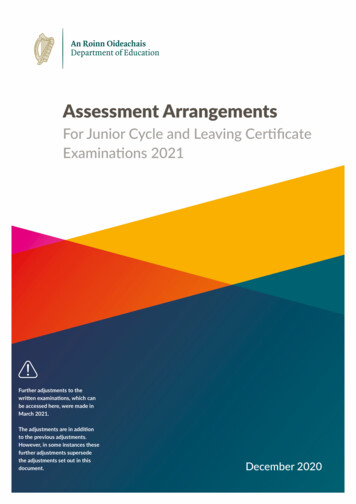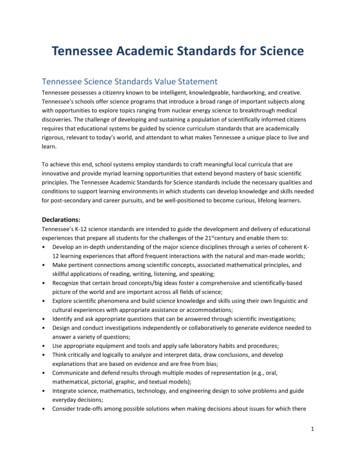
Transcription
Assessment ArrangementsFor Junior Cycle and Leaving CertificateExaminations Further adjustments to thewritten examinations, which canbe accessed here, were made inMarch.The adjustments are in additionto the previous adjustments.However, in some instances thesefurther adjustments supersedethe adjustments set out in thisdocument.December
IntroductionThis updated document sets out theadjusted assessment arrangementsfor post-primary students takingcertificate examinations in the school year. Thesearrangements are designed to takeaccount of the disrupted learningexperienced by students duringthe /20 school year. Theadjustments have been arrived atthrough discussions between theDepartment of Education (DE), theState Examinations Commission(SEC) and the National Council forCurriculum and Assessment (NCCA)and key stakeholders.As the loss of learning throughschool closures will have affectedstudents’ engagement with theircourse of study in different ways, theadjustments put in place will play tostudent strengths by leaving intactthe familiar overall structure of theexaminations, while incorporatingadditional choice. In some cases, theadjustment measures will providemore time for tuition by, for example,reducing preparatory work forpractical examinations. In addition,briefs for coursework will be issuedat least a month earlier in the schoolyear to provide certainty for students.As schools have significant autonomyin determining how to sequenceand pace learning for students intheir schools, no centrally prescribedadjustment of the curriculum andcourses of study would be effectivefor students taking the certificateexaminations in. Consequently,the most appropriate way to reflectand take account of the challengesfor students that have occurred in2019/20 and may occur in /21is to incorporate adjustments to thecertificate examinations in.Changes to the national assessmentarrangements have been made withdue regard for the principles ofequity, fairness and integrity as theseprinciples apply to assessment andexaminations and refer to studentto-student, subject-to-subject, andyear-to-year comparisons.ASSESSMENT ARRANGEMENTS -2-Overall, the changes can be viewedas reflecting and recognising a loss oflearning time in the /20 schoolyear in a fair manner, with somecontingency for future learning lossthat may occur during the /21school year also built in. They provideclarity, certainty and reassurance tostudents, their parents/guardians,teachers and schools in advance ofthe start of the schoolyear.The document details the adjustedassessment arrangements for everysubject/ module descriptor in theLeaving Certificate Established,Leaving Certificate Applied, LeavingCertificate Vocational Programmeand Junior Cycle programmes. Whenyou click on the relevant subjecttitle, you will be brought to the pagedetailing the particular arrangementsfor that subject.
SeniorCycleSENIOR CYCLEFor the Leaving CertificateEstablished, Leaving CertificateApplied and Leaving CertificateVocational Programme examinations,there will be no change to the lengthof the written examinations. Forsubjects where the SEC issues projectbriefs during the /21 schoolyear, the intention is to generallyissue these at least four weeks earlierthan normal. In the case of thesesubjects, where the courseworkcompletion dates are late in theschool year, the coursework shouldbe completed two weeks earlier thannormal as a contingency measure. Inthis context, teachers are encouragedto plan and undertake these projectsas early as possible in the programmeof study.In the case of subjects wherethe coursework briefs issued inthe school year andhave a completion date late in the school year, normaltimelines for completion apply.The adjusted assessmentarrangements to the LCA programmeand LCVP are accessed by clickingthe programme title on the right.Further adjustments to thewritten examinations, which canbe accessed here, were made inMarch.The adjustments are in additionto the previous adjustments.However, in some instances thesefurther adjustments supersedethe adjustments set out in thisdocument.AccountingAgricultural ScienceAncient GreekApplied MathsArabicArt (including Craft)BiologyBusinessChemistryClassical StudiesComputer ScienceConstruction StudiesDesign shFrenchGeographyGermanHebrew StudiesHistoryHome EconomicsScientific and sics & ChemistryPhysical EducationPhysicsPolitics and SocietyReligious EducationRussianSpanishTechnologyLeaving CertificateApplied ProgrammeLeaving CertificateVocational ProgrammeSPHE RESOURCESNon-Curricular-3Languages
JuniorCycleJUNIOR CYCLEWith regard to Junior Cycle, theNational Council for Curriculum andAssessment (NCCA) has publishedthe revised arrangements forClassroom-Based Assessments forstudents entering third year in,and these are available here:CBA revised arrangements for cohortof third-year students /21.The number of CBAs to be completedby these students has been reducedand each student must complete onlyone CBA in each subject and shortcourse. The dates for the completionof CBA1 for that cohort has beenextended into the new school year.Students taking the junior cycle finalexaminations in will not berequired to complete AssessmentTasks for the relevant subjects.The grade descriptor awarded forthese subjects will be based on theexamination paper only. Specificarrangements have been put in placefor Music, Art and Home Economicsand are detailed in the relevantsection.Ancient GreekVisual ArtBusiness StudiesClassical StudiesEnglishFrenchGermanGeographyHistoryHome EconomicsIrishItalianJewish StudiesLatinMathematicsMetalworkMat. Tech. WoodMusicReligious EducationScienceSpanishTechnical GraphicsTechnologyAdjustments have been made tothe examination components of thefollowing Junior Certificate subjects: Ancient GreekClassical StudiesJewish StudiesASSESSMENT ARRANGEMENTS -4- LatinReligious EducationTechnologies:Technology,Technical Graphics, MaterialsTechnology - Wood andMetalwork
HOMEACCOUNTINGSENIOR CYCLELEVELCURRENT ARRANGEMENT ADJUSTMENTSHigher &OrdinaryWRITTEN; EXAMINATIONWRITTEN EXAMINATIONSection 1 – Financial AccountingQ1 – 120 marksAn additional alternative Q1 will be provided(Sole/Company/Manufacturing) to providechoice.Q2, Q3, Q4 – answer any twoNo adjustment.Section 2 – Financial AccountingQ. 5 will be on Interpretation of AccountsSection 3 – Management AccountingNo adjustment.Further adjustments to the written examinations can be accessed here.ASSESSMENT ARRANGEMENTS -5-
HOMEAGRICULTURALSCIENCESENIOR CYCLELEVELCURRENT ARRANGEMENT ADJUSTMENTSHigher &OrdinaryCOURSEWORKCOURSEWORKFurther; guidance in relation to the brief wasissued by the SEC.WRITTEN EXAMINATIONWRITTEN EXAMINATION No adjustment. No adjustment. Total marks for the written paper is 300marks.Paper is 2.5 hours in duration at bothlevels.The sample paper to be publishedin Autumn will be designed toexemplify the structure of examinationpapers from onward. It will contain 2sections A and B.»Section A will be a series of unrelatedshort questions (10 questions at 10marks each) some of which will bestructured, some synoptic and some amixture of both. Some internal choiceon two questions.»Section A – an increase in choice with12 questions provided and 10 to beanswered. In addition, there will besome internal choice through internaloptionality in four questions.»Section B will comprise long questions(five questions to answer four at 50marks each), with structured, synopticand a mixture of both question types.»Section B – there will be an increasedchoice with six questions provided toanswer four questions, with internaloptionality in two questions.Further adjustments to the written examinations can be accessed here.ASSESSMENT ARRANGEMENTS -6-
HOMEANCIENT GREEKSENIOR CYCLELEVELCURRENT ARRANGEMENT ADJUSTMENTSHigherWRITTEN EXAMINATIONWRITTEN EXAMINATIONTotal of four questions Question 1Question 2Question 3Prescribed Text* (see below)Answer Part A (i) Translate from Greek and(ii) Answer any three questions from a totalof five questions or Part B (i) Translate fromGreek and (ii) Answer any three questionsfrom a total of five questionsQuestion 4Answer three questions (on history, artand architecture, and literature). One fromsection A (total of four questions). Onefrom section B (total of four questions).And one from either section.*Prescribed TextThe Joint Association of Classical Teachers’Greek Course: The Intellectual Revolution(published by Cambridge University Press,2nd edition): Part III Plato, Pages 131– 151 inclusive. (Selections in Greek and intranslation, from Plato’s Apology and Phaedo)orThe Joint Association of Classical Teachers’Greek Course: A World of Heroes (publishedby Cambridge University Press, 2nd edition): Part I Homer, Pages 6 – 53 inclusive.(Selections in Greek and in translation, fromHomers’ Iliad, Book XXII.) No adjustmentNo adjustment3 A (i) and 3 B (i) Reduce the amount ofprescribed text to be studied ** (see below)3 A (ii) Increased internal choice: Answerany three from a total of seven questions3 B (ii) Increased internal choice: Answerany three from a total of seven questions Answer any three from a list of eightquestions.(The necessity to answer from both sectionA and section B is removed.) The eightquestions will cover the same range oftopics (on history, art and architecture, andliterature) as in previous years.**Reduced Prescribed TextThe Joint Association of Classical Teachers’Greek Course: The Intellectual Revolution(published by Cambridge University Press,2nd edition): Part III Plato, Pages 131– 146 (up to the end of Section 25) inclusive.(Selections in Greek and in translation, fromPlato’s Apology)orThe Joint Association of Classical Teachers’Greek Course: A World of Heroes (published byCambridge University Press, 2nd edition):Part I Homer, Pages 6 – 46 (up to line 404,the end of Section 16) inclusive. (Selections inGreek and in translation, from Homers’ Iliad,Book XXII.)Further adjustments to the written examinations can be accessed here.ASSESSMENT ARRANGEMENTS -7-
HOMEANCIENT GREEKSENIOR CYCLELEVELCURRENT ARRANGEMENT ADJUSTMENTSOrdinaryWRITTEN EXAMINATIONWRITTEN EXAMINATIONTotal of three questions Question 1Question 2Prescribed Text* (see below)Answer Part (i) Translate from Greek andPart (ii) Answer any four questions from atotal of six questions.Question 3Answer three questions (on history, art andarchitecture, and literature).One from section A (total of fourquestions). One from section B (totalof four questions). And one from eithersection.*Prescribed TextThe Joint Association of Classical Teachers’Greek Course: Reading Greek — Text andVocabulary (published by Cambridge UniversityPress, 2nd edition), Sections Fifteen toTwenty (inclusive). No adjustment.2 (i) Reduce the amount of prescribed textto be known** (see below)2 (ii) Increase internal choice: Answer anyfour from a total of eight questions. Answer any three from a list of eightquestions. (The necessity to answer fromboth section A and section B is removed.)The eight questions will cover the samerange of topics (on history, art andarchitecture, and literature) as in previousyears.**Reduced Prescribed TextThe Joint Association of Classical Teachers’Greek Course: Reading Greek — Text andVocabulary (published by Cambridge UniversityPress, 2nd edition), Sections Fifteen toNineteen (inclusive).Further adjustments to the written examinations can be accessed here.ASSESSMENT ARRANGEMENTS -8-
HOMEAPPLIED MATHSSENIOR CYCLELEVELCURRENT ARRANGEMENT ADJUSTMENTSHigher &OrdinaryWRITTEN; EXAMINATIONWRITTEN EXAMINATIONNo adjustment.This examination already has a very widedegree of choice.Further adjustments to the written examinations can be accessed here.ASSESSMENT ARRANGEMENTS -9-
HOMESENIOR CYCLEARABICLEVELCURRENT ARRANGEMENT ADJUSTMENTSHigher &OrdinaryREADING; COMPREHENSIONREADING COMPREHENSIONNo adjustment.LITERATURELITERATURECandidates must answer both of the questionsset in any two of the following three areas:An increase in the level of choice will be madeavailable to candidates. This will be achievedby including one extra question in each of thefollowing areas: The Koran (35 marks x 3) Classical Arabic verse (35 marks x 3) Modern Arabic prose (35 marks x 3) The Koran (35 marks x 2)Classical Arabic verse (35 marks x 2)Modern Arabic prose (35 marks x 2)In total candidates answer four questions in theLiterature section of the paper.LANGUAGE USE/GRAMMARCandidates will be required to answer any fourof the nine questions provided.LANGUAGE USE/GRAMMARNo adjustment.CONTINUOUS WRITING/COMPOSITIONCONTINUOUS WRITING/COMPOSITIONNo adjustment.Further adjustments to the written examinations can be accessed here.ASSESSMENT ARRANGEMENTS - 10 -
HOMEART(INCLUDING CRAFT)SENIOR CYCLELEVELCURRENT ARRANGEMENT ADJUSTMENTSHigher &OrdinaryCOURSEWORKCOURSEWORKBased; on a brief issued by the SEC, eachcandidate must research, develop and executetwo artefacts during a coursework period.Each candidate will research, develop andexecute one artefact during the same length ofcoursework period as normal. Brief will issueearlier with a closing date of mid-MarchINVIGILATED PRACTICAL EXAMINATIONINVIGILATED PRACTICAL EXAMINATIONInvigilated exam in which candidates make twodrawings of a model in two different set poses.This component will not be assessed in.The marks associated with this component willnot be reallocated and Art will be marked andgraded using the other components based ontheir normal mark allocations.WRITTEN EXAMINATIONWRITTEN EXAMINATIONThree sections –Three sections – Irish ArtEuropean Art (1,000 AD – Present),Appreciation of ArtIrish ArtEuropean Art (1,000 AD – Present),Appreciation o
